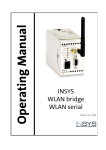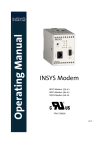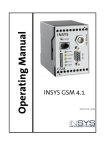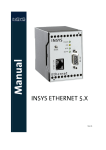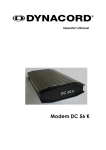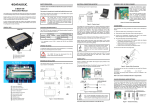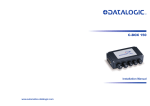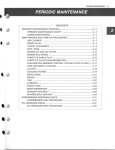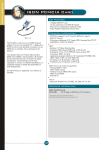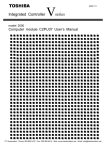Download Insys Modem 56k 4.1 m/UL
Transcript
Operating Manual INSYS Modem 56k File E239995 Juni 05 Copyright © March June 05 INSYS MICROELECTRONICS GmbH Any duplication of this manual is prohibited. All rights on this documentation and the devices are with INSYS MICROELECTRONICS GmbH Regensburg. Restrictions of guarantee This handbook contains a concise description. The compilation of the text has been made with the utmost care. Despite all efforts, there may be deviations compared with the actual functions. No guarantee can therefore be given for the accuracy of the contents. We can neither take over a legal responsibility nor any liability for incorrect information and their consequences. Suggestions for improvements and comments are gladly accepted. Trademarks The use of a trademark not shown below is not an indication that it is freely available for use. MNP is a registered trademark of Microcom Inc. IBM PC, AT, XT are registered trademarks of International Business Machine Corporation. INSYS ® is a registered trademark of INSYS MICROELECTRONICS GmbH. Windows™ is a registered trademark of Microsoft Corporation. Publisher: INSYS MICROELECTRONICS GmbH Waffnergasse 8 D-93047 Regensburg, Germany Phone: +49 (0)941/58692-0 Fax: +49 (0)941/563471 e-mail: [email protected] Internet: http://www.insys-tec.de Subject to technical changes as well as correction. Date: June 05 31-22-03.031 english INSYS Modem 56k UL 1 SCOPE OF DELIVERY ................................................... 4 2 GENERAL .................................................................... 4 3 INITIAL OPERATION.................................................... 5 3.1 IMPORTANT SAFETY INSTRUCTIONS ! ................................... 5 3.2 INSTALLATION OVERVIEW ........................................................... 5 3.3 INSTALLATION STEPS .................................................................. 6 4 CONFIGURATION........................................................ 7 4.1 CONFIGURATION SOFTWARE HSCOMM ......................................... 7 4.1.1 4.1.2 HSComm Operation ........................................................................... 7 AT Commands For Settings ................................................................ 8 4.2 SERIAL INTERFACE ...................................................................... 8 4.2.1 4.2.2 4.2.3 4.2.4 PC Settings.......................................................................................... 9 INSYS Modem Settings....................................................................... 9 Idle Connection Control ..................................................................... 9 AT Commands For The Serial Line .................................................... 10 4.3 TELEPHONE INTERFACE ............................................................. 10 4.3.1 4.3.2 4.3.3 4.3.4 4.3.5 Error Correction ................................................................................ 10 International Settings ...................................................................... 11 Dial Tone Detection.......................................................................... 11 Auto Answer Mode........................................................................... 11 AT Commands For The Telephone Line ............................................ 11 4.4 ACCESS PROTECTION ................................................................ 12 4.4.1 4.4.2 4.4.3 Password Protection......................................................................... 12 Security Callback .............................................................................. 12 AT Commands For Access Protection ............................................... 13 4.5 CONTROL OUTPUT ................................................................... 13 Juni 05 Content I Content INSYS Modem 56k UL 4.6 ALARM INPUT ......................................................................... 13 4.6.1 4.6.2 Alarm Trigger.................................................................................... 14 Alarm Actions ................................................................................... 15 4.6.2.1 4.6.2.2 4.6.2.3 4.6.2.4 4.6.2.5 Simple alarm ........................................................................................................15 Impulse alarm ......................................................................................................15 Collective fax massage ........................................................................................15 Connection...........................................................................................................15 SMS in the fixed network ....................................................................................15 4.6.3 AT Commands For Alarm Actions..................................................... 16 4.7 COMMAND INPUT MODE .......................................................... 16 4.8 REMOTE CONFIGURATION ......................................................... 17 4.9 VOICE MODE AND DTMF TRANSMISSION ................................... 18 4.9.1 4.9.2 4.9.3 DTMF Sounds.................................................................................... 18 Remote Switching and Status Query ............................................... 18 AT Commands for Voice and DTMF Mode ....................................... 19 4.10 FIRMWARE UPDATE ................................................................. 19 4.10.1 Upload Procedure ............................................................................. 20 4.10.2 AT-Commands For Firmware Update............................................... 20 II 5 TECHNICAL DATA ..................................................... 21 5.1 GENERAL................................................................................ 21 5.1.1 5.1.2 Key Features ..................................................................................... 21 Mechanical Features ........................................................................ 21 5.2 INTERFACES AND DISPLAY ELEMENTS .......................................... 22 5.2.1 5.2.2 5.2.3 5.2.4 5.2.5 5.2.6 5.2.7 Display Elements .............................................................................. 22 Terminal Layout................................................................................ 22 Power Supply.................................................................................... 23 Reset ................................................................................................. 24 Serial Interface ................................................................................. 24 Interface speed................................................................................. 24 Phone Interface ................................................................................ 25 Juni 05 INSYS Modem 56k UL 5.2.8 Digital Inputs and Outputs............................................................... 26 5.2.8.1 5.2.8.2 Alarm input: .........................................................................................................26 Control output: ....................................................................................................26 5.3 TRANSMISSION STANDARDS/PROTOCOLS .................................... 26 5.4 FIRMWARE ............................................................................. 27 5.5 APPROVALS ............................................................................ 27 6 COMMAND OVERVIEW ............................................ 28 6.1 AT COMMAND AND S-REGISTER OVERVIEW ............................... 28 6.2 SYNTAX OF THE STANDARD AT COMMANDS ............................... 28 6.3 MESSAGES RETURNED FOR NORMAL DATA COMMUNICATION ........ 29 6.4 S REGISTER ............................................................................. 29 6.5 SHORT OVERVIEW S REGISTER ................................................... 29 7 OPERATION WITH PLCS ............................................ 31 8 COUNTRY CODES...................................................... 32 Juni 05 Content III Sope Of Delivery 1 INSYS Modem 56k UL Scope Of Delivery Please check that the box contains all of the following parts before installation and operation: • 1 INSYS Modem 144 or INSYS Modem 336 or INSYS Modem 56K • 1 TAE cable • 1 RS 232 cable (9 pin plug to 9 pin jack) • 1 operating manual If any part is missing, please contact your supplier. Please also inspect the modem for transport damage and in the event of damage, consult your supplier. Please keep packaging for future dispatch or storage. 2 General The INSYS Modem 336/56k is a modem for the analogue telephone network (PSTN). INSYS Modem 336/56K provides plenty of advantages for professional users. The mounting on DIN rail in your cabinet is very simple, as well as installation and operation. The features will be explained in the following sections • Establishment of a data connection • Auto answer mode • Security callback • Data flow control • Idle connection control (Data transmit control) • Flash update • Alarm input and output for SMS messages transmission and for alarm data connections • Impulse input for dispatching up to 10 SMS messages (only INSYS Modem 144) • Fax dispatch with alarm release • Local and remote parameterization • INSYS Modem 56K usable in over 80 countries of the world • SMS transmission in the fixed network • 2 alarm inputs, 2 control outputs • switch control outputs by DTMF 4 Juni 05 INSYS Modem 56k UL 3 Initial Operation Initial Operation 3.1 IMPORTANT SAFETY INSTRUCTIONS ! When using your telephone equipment, basic safety precautions should always be followed to reduce the risk of fire, electric shock and injury to persons, including the following: 1. Do not use this product near water, for example, near a bath tub, wash bowl, kitchen sink or laundry tub, in a wet basement or near a swimming pool. 2. Avoid using a telephone (other than a cordless type) during an electrical storm. There may be a remote risk of electric shock from lightning. 3. Do not use the telephone to report a gas leak in the vicinity of the leak. SAVE THESE INSTRUCTIONS 3.2 Installation Overview Juni 05 5 Initial Operation 3.3 Installation Steps 1. 2. Mounting on DIN rail: simply clip on Power supply: a) Connect earth cable to GND b) Connect power supply cable to 10..60 VDC Note: Maximum ratings at pins 2 and 3 must not be exceeded! c) Connect to power supply The power LED lights up on successful installation. INSYS Modem 56k UL 1 1 2 2 GND X1 3 3 10...60 VDC 4 4 GND 5 5 GND 6 RESET 7 6 7 8 8 INPUT 1 9 9 INPUT 2 10 10 GND GND Telephone network: a) Plug the TAE cable into the middle of the RJ-45 socket on the front of the housing or alternatively install via screw terminal on the bottom according to description (b2, b1, a1, a2, NC). c) connect cable to the TAE plug Disconnect the INSYS Modem 144/336/56K from the phone line immediately in case of any fault or functional irregularities – e.g. when the OFF-Hook-LED switches on immediately - and contact your service partner. In order to preserve your guarantee please do not open or interfere with the modem. 3. 4. Connecting PC/terminal: Plug the enclosed RS 232 interface cable into housing front and connect with PC/terminal. 5. Checking successful installation: Execute a short test from your terminal program (e.g. HSComm terminal window, HyperTerminal, TeraTermPro, ProcommPlus). Enter the command “AT” and press the “ENTER” button. If “OK” appears on your screen the INSYS Modem 144/336/56K has been successfully installed. 6. Connection test: Start a connection from your terminal program: • Dial the following number 0101901929 (ATDT0101901929) Attention: For PABXs which require a „0“ for connection set-up, please enter the following ATX3DT0,0101901929 • OFF-Hook-LED lights up • Modem dials • After some time (not more than 1 minute) the CONNECT message appears and the DCD LED switches on 6 Juni 05 INSYS Modem 56k UL 4 Configiration Configuration 4.1 Configuration Software HSComm INSYS Modem is configured by AT commands from a terminal program or PLC. All basic functions of INSYS Modem can be controlled by the configuration software HSComm without any knowledge about single commands and parameters. The description of settings within HSComm is followed by a list of corresponding AT commands. A terminal window within HSComm allows direct command input when required. A complete description of all AT commands and registers is available in a separate document. HSComm is running under Microsoft Windows from version 95. 4.1.1 HSComm Operation HSComm tests the type of the connected device at startup or by menu Device Æ Test device and displays name and firmware revision in the upper right corner of the program window. By default settings are available only when the corresponding firmware revision has been recognized by the test. The buttons in the right column of the window allow to read out the current settings, to reset the modem or to set it back to factory settings. All parameter settings are transmitted to the modem after pushing the SEND button. Configurations can be saved and restored by the commands of the File menu. Error messages of the modem are displayed in the Error menu. For operation in connection with PLCs refer to chapter 7. The key F1 provides a help window for the currently selected option at any time. Juni 05 7 Configuration INSYS Modem 56k UL 4.1.2 AT Commands For Settings Command Description AT&F load factory settings AT&V display settings AT&W save user settings ATZ software reset A comprehensive description of all AT commands and parameters is available in the addendum „command overview“. 4.2 Serial Interface Both devices on the serial line (PLC or PC on one side and INSYS Modem on the other) have to agree on the following settings for the serial line: • baud rate (data transmission speed): • format (start, data, parity and stop bits) • flow control ( hardware/software handshake) 8 Juni 05 INSYS Modem 56k UL Configiration 4.2.1 PC Settings Within HSComm the serial line setting are configured by the menu interface. The actual settings are displayed in the status line of the program window. Note: Serial setting has to be configured in any device (PC or PLC) connected to the INSYS Modem. 4.2.2 INSYS Modem Settings Serial line settings of the INSYS Modem are accessed by the menu Configure Æ Modem. Autobauding: the INSYS Modem recognizes baud rate and format of incoming data at the first AT command. The last settings persist unchanged if the modem receives data (e.g. when answering a call). Handshake is controlling data flow in case one of the devices is not ready to receive more data temporarily. Hardware handshake is realized by separate control lines within the serial interface. DTR handling The signal Data Terminal Ready (DTR) of the serial line indicates that the device (PLC, PC) is switched on, connected and ready. INSYS Modem can react if the device is switched off or a cable is disconnected. Echo When Echo is set INSYS Modem transmits each command back on the serial line to the sender. This is necessary to see the command input in terminal mode. 4.2.3 Idle Connection Control Idle connection control (formerly data transmit control) is a firmware function to monitor data transmission on the serial line in online mode. It avoids long time connection without data transmission. A counter starts as soon as the connection is established. Each byte which is transmitted over the serial line resets the counter. The modem is reset when the predefined time is reached without any data transmission or reception on the serial line. As the counter starts at off hook idle time should not be set to less than 30 seconds to allow full connection establishment. Juni 05 9 Configuration INSYS Modem 56k UL Data transmission on the remote line does not reset the counter. Idle connection control of the remote modem must be switched off for remote control therefore. Idle connection control is configured by AT command only. 4.2.4 AT Commands For The Serial Line Command Description AT*S data transmission speed on serial line AT+IPR autobauding, baud rate (INSYS Modem 56k only) AT*U serial line protocol AT&K flow control between PC and modem ATE command echo AT&S DSR handling AT&C DCD (CT109) handling AT&D DTR (CT108/2) handling ATS11= Idle connection control (INSYS Modem 144/336 only) ATS15= Idle connection control (INSYS Modem 56k only) A comprehensive description of all AT commands and parameters is available in the addendum „command overview“. 4.3 Telephone Interface 4.3.1 Error Correction Error correction according to V.42 or MNP (1-4) standards enables the modem to recognize and correct transmission errors by line disturbances. Transmission may be interrupted without error correction. The type of error correction can be selected by the HSComm menu Configure Æ Modem Æ Error correction. With the settings V.42 connection only, MNP4 connection only and V.42 or MNP4 connection only connection is refused if the other modem does not support this error correction. For connections with the requirement of short answer times the setting buffered, no error correction avoids any delays by block transmission. Error corrected connections allow additional data compression. In unbuffered, bit-direct mode up all bits are transmitted without buffering, error correction or compression. The modem does not influence the transmission format in any way. Only the escape sequence (+++) is interpreted by the modem as long as the data format is up to 11 bits. 10 Juni 05 INSYS Modem 56k UL Configiration 4.3.2 International Settings INSYS Modem 56k can be adjusted to the line requirements of 87 countries worldwide by a configuration command. The country codes for the firmware versions “standard countries” and “further countries” are listed in chapter 8. Some countries do not require a separate adaptation but are using the standards “TBR21 (Europe)” or “ITU/Taiwan”. TBR21 is the accurate setting for the countries of the European Union, Switzerland, Liechtenstein, Norway and Iceland. Select the explicit country code only when INSYS Modem is connected to an older private branch exchange (PBX). INSYS Modem 144 and 336 are configured for operation in western Europe (TBR21) only. 4.3.3 Dial Tone Detection When dial tone detection is active, a dial attempt without the presence of a dial tone being detected is aborted with the message NO DIALTONE. Without dial tone detection dialing is attempted and reports NO CARRIER if not successful. Dialing without dial tone detection is often required behind a private branch exchange (PBX). Attempts to call a busy line is answered by the message BUSY in both cases. 4.3.4 Auto Answer Mode The modem is answering incoming calls after the specified number of RING indications autonomously. 4.3.5 AT Commands For The Telephone Line Command Description ATA answer mode AT*A auto answer mode lock ATB modulation for 300 Baud AT\B send break signal AT%B power up and down of the key abort at dial-up AT%C Enable data compression AT\N select error correction ATW error correction messages AT\A MNP block size AT*L auto speed limit AT+MR modulation type display (INSYS Modem 56k only) AT+MS modulation type selection AT%E retrain AT+GCI country code selection (INSYS Modem 56k only) ATD dial ATH hang up Juni 05 11 Configuration INSYS Modem 56k UL Command Description ATP Select pulse dialing ATT Select tone dialing AT%Q Display phone connection quality ATS0 auto answer AT+VCID set caller ID (INSYS Modem 56k only) AT+VRID last received caller ID (INSYS Modem 56k only) AT\V connect messages ATX Extended result reporting, dial tone detection AT%L Display level of received signal AT&Z Store phone numbers A comprehensive description of all AT commands and parameters is available in the addendum „command overview“. 4.4 Access Protection 4.4.1 Password Protection With password set the modem is protected from unauthorized access • for incoming data connections • for remote control • for security callback 4.4.2 Security Callback When the modem answers an incoming call the message “CONNECT” is followed by the messages “SECURITY CALLBACK” and “REMOTE PASSWORD:”. • If the password is wrong the modem immediately disconnects and stops an unauthorized access. • If the password is correct the modem reports "OK" to the calling terminal, disconnects and dials the phone number specified after 10 seconds. Up to 3 call attempts are executed with 10 seconds breaks in between. • 2 seconds after the connection the message “CALLBACK IN PROGRESS” is sent by the calling modem and the serial line is released for a standard data connection. Outgoing calls are not influenced by the security callback functionality. 12 Juni 05 INSYS Modem 56k UL Configiration 4.4.3 AT Commands For Access Protection Command Description AT*P password request after dial-up AT*C remote control password AT*C1 PIN for DTMF control AT*R turn on/off remote control AT\D turn on/off DTMF for digital IO AT&Z1= store security callback number AT&A selective call answer according to caller IDs (INSYS Modem 56k only) AT*N allowed numbers for selective call answer (INSYS Modem 56k only) AT%N last rejected number (INSYS Modem 56k only) A comprehensive description of all AT commands and parameters is available in the addendum „command overview“. 4.5 Control Output INSYS Modems 144/336/56k from version 4.0 provide two control outputs OUT1 and OUT2 at the bottom of the housing. These outputs are realized as SPDT (single pole double throw) switches by galvanic insulated relays. The outputs are controlled independently by software commands. OUT1 is closed automatically during impulse alarm processing. Control outputs can be switched remotely: • within a remote configuration session (see chap. 4.8) • by DTMF signals (see chap. 4.9.2) AT Commands For Control Output Command Description AT*Y output switching A comprehensive description of all AT commands and parameters is available in the addendum „command overview“. 4.6 Alarm Input INSYS Modems 144/336/56k from version 4.0 provide two digital inputs which are activated by ground potential. In case of an alarm the modem transmits an alarm notification by data connection, as a fax or an SMS. If the impulse alarm is activated the modem distinguishes up to 10 pulse sequences. Each of these 10 alarm events correlates to user defined alarm text and receiver. The status of the alarm inputs can be queried by AT command or by DTMF signals (see chap. 4.9.2) Juni 05 13 Configuration INSYS Modem 56k UL 4.6.1 Alarm Trigger The alarm inputs are on HIGH potential provided by internal pull-up resistors as long as it is open. The alarm is activated by a simple connection to the ground potential. The alarm input is configured by the HSComm menu Configure Æ Alarm functions: • With alarm input active a simple alarm is triggered as soon as INPUT1 is set to ground potential for 4 seconds. • With impulse input active pulses (pulses and pauses with duration of 0,3 to 2 seconds) at INPUT1 are counted and processed after a delay of 5 seconds. If INPUT1 is kept at ground potential for more than 4 seconds a simple alarm only is triggered for compatibility reasons. Activation of INPUT2 is interpreted like 2 pulses on INPUT1. Simple and impulse alarms can be triggered by software commands for control purposes. 14 Juni 05 INSYS Modem 56k UL Configiration 4.6.2 Alarm Actions SMS transmission from the analog telephone network is routed by special gateway numbers of the network providers. These Service Center Numbers and the protocol (PET or UCP) are preconfigured for German GSM networks. 4.6.2.1 Simple alarm Alarm notifications consist of an alarm text of a maximum of 160 characters. The notification is transmitted to a modem over data connection or to mobile phone by SMS. 4.6.2.2 Impulse alarm With impulse alarm active alarm notification are composed from 120 characters common text for all alarms and 80 characters individual alarm text – the first 160 characters are transmitted by SMS. The alarm index is specified by the number of pulses. If more than 10 pulses are applied message 10 is transmitted. The notifications are transmitted to mobile phones by SMS. All recipients must be located within the network of the same GSM provider. Attention: alarm number 1 must be configured in any case to activate impulse alarming. 4.6.2.3 Collective fax massage In addition all alarm notifications can be sent to a central fax number for logging. 4.6.2.4 Connection If a connection can not be established 3 dial attempts with 10 seconds breaks in between are executed. Alarm notification is aborted if no connection was successful. A new connection is only initiated when the alarm input is opened and closed again. Data connection to a modem can remain after the transmission of the notification with the selection data connection, keep connection. After fax or SMS transmission the connection is closed by the modem in any case. A dial prefix is necessary for the service center numbers only, not for the single target numbers. 4.6.2.5 SMS in the fixed network SMS gateways in the fixed network are supported by the latest firmware. SMS in the fixed network can be transmitted as well to fixed telephones as to a fax or a e-mail address. The following access data are from Deutsche Telekom: Service-Center: 01930100 SMS to fax: set prefix 99 ahead of fax device number SMS to e-mail: set recipient number to 8000 (SMS-e-mail gateway) text message begins with e-mail address, followed by a space and the message. Replace @ in the e-mail address by an asterisk *. (Note: The common text must be empty or start with the e-mail address for pulsed alarm.) Juni 05 15 Configuration INSYS Modem 56k UL 4.6.3 AT Commands For Alarm Actions Command Description AT%A alarm triggering AT*I manual request of the alarm input AT*M protocol for alarm messages AT*V alarm text AT&Z store telephone numbers (mobile, service center, fax) ATS13 number of dialing attempts A comprehensive description of all AT commands and parameters is available in the addendum „command overview“. 4.7 Command Input Mode At power up INSYS Modem is in the command input mode ready to receive AT commands from the serial line. When a data connection is established the modem can be set back to command input mode by the following escape sequence: 1 second break (no input) 3 plus characters (+++) without Return 1 second break (no input) Data connection is held in the background. AT Commands For Command Input Mode Command Description ATO switch to online data mode <break> +++ <break> switch to command input mode A comprehensive description of all AT commands and parameters is available in the addendum „command overview“. 16 Juni 05 INSYS Modem 56k UL Configiration 4.8 Remote Configuration To change into remote configuration mode a data connection must exist between the modems. A specific protocol is not necessary, however it is recommended to use an error corrected connection to avoid transmission errors of critical commands. The local modem does not require any remote configuration functionality. Remote configuration is imitated by the following escape sequence (e.g. in the terminal window): 1 second break (no input) 4 asterisk characters (****) without Return 1 second break (no input) If hardware handshake is active in the remote modem the handshake signals have to be active for the start of remote configuration. Otherwise hardware handshake should be switched off. Some commands are not available in remote configuration mode and are answered by ERROR: ATA, ATD, ATO, AT\B, AT*C, AT*C1, AT&F, AT*V. Attention: Idle connection control of the remote modem must be switched off because the counter is only reset by characters on the serial line, which is not in use during remote configuration. Idle connection control can be switched off at the beginning of the remote configuration session. Remote configuration is executed only by AT commands, e.g. from the HSComm terminal window, but not by HSComm Configure menu. AT Commands For Remote Configuration Command Description AT*C store remote configuration password (presettings are QWERTY) <break> **** <break> initiate remote configuration AT*R1 release modem for remote configuration AT*E / AT*X terminate remote configuration ATS11 / ATS15 idle connection control A comprehensive description of all AT commands and parameters is available in the addendum „command overview“. Juni 05 17 Configuration INSYS Modem 56k UL 4.9 Voice Mode and DTMF Transmission The voice mode of the modem allows • to digitize telephone audio data and to transmit them over the serial line • to play back digitized audio data to the telephone line • to transmit and receive control signals as DTMF 4.9.1 DTMF Sounds Keyboards of fixed network and mobile telephones produce DTMF sounds for the characters (0..9, A..D, *, #) as a combination of two frequencies which do not occur in the human voice. DTMF sounds are used for dialing in the telephone network. They may be used as well to transmit control signals during a voice connection – e.g. for answering machines or telebanking. 4.9.2 Remote Switching and Status Query The latest firmware updates for INSYS Modem 144/336/56k 4.0 from January 2003 allow to set the control outputs and to query the status of the alarm inputs by DTMF signals. The INSYS Modem is ready to receive DTMF signals in incoming calls when the DTMF mode has been activated. The connect is indicated by the OK signal and must be answered by a 4 digit PIN. The PIN is acoustically acknowledged. The following commands are available for remote DTMF control by telephone keyboard: Key Description 0* Close connection 1*x Control output 1: x: 1 set control output 1 to 1 0 reset control output 1 1 set control output 2 to 1 0 reset control output 2 Return: „OK“ 2*x Control output 2: x: Return: „OK“ 3* Status query of both alarm inputs: Status of both inputs is indicated in the form of HIGH (not active) or LOW (active). Return: „OK“ – Status Input 1 – Status Input 2 The connection is closed by the INSYS Modem after a idle time of 25 seconds without further DTMF signals. 18 Juni 05 INSYS Modem 56k UL Configiration The INSYS Modem switches to data mode if it receives the call signal for a data connection from a modem. Acoustic Signals Description short deep sound – short break – short high sound OK ready, command executed, PIN ok long deep sound ERROR invalid command, wrong PIN LOW alarm input active HIGH alarm input not active long high sound 4.9.3 AT Commands for Voice and DTMF Mode The AT command sets of INSYS Modem 144/336 and INSYS Modem 56k have a similar content but partly different naming. The comprehensive description of AT commands for voice functions are available as separate documents from INSYS MICROELECTRONICS. Command Description AT\D1 activate DTMF mode AT\D0 deactivate DTMF mode AT*C1 PIN for DTMF commands (factory setting „0000“) 4.10 Firmware Update INSYS Modem contains a flash EPROM which allows a firmware update without hardware manipulations. The latest firmware can be requested from your service partner. It consists of the flash loader (file HS_LADER.s37) and the firmware code (file with extension .S37). The update is executed by a terminal program, which can perform an ASCII upload (ASCII text transmission protocol), running on a PC. Tested an recommended terminal programs are TeraTermPro, ProcommPlus and HyperTerminal (included in Windows). The following settings in the terminal program are mandatory: • hardware handshake • no interpretation of characters like tab stop, line feed, carriage return, backspace • baud rate between 9.600 baud and 57.600 baud The upload procedure takes 2 to 3 minutes at 57.600 baud, , longer with lower baud rates. Juni 05 19 Configuration INSYS Modem 56k UL 4.10.1 Upload Procedure 1. Upload is initiated by the AT command AT** - the modem replies „Download initiated“. 2. ASCII upload of the flash loader HS_LADER.S37. The transmission process is displayed by dots in some terminal programs. Upon termination the message „Download Flashcode“ is displayed. 3. ASCII upload of the firmware code (file xxxxxxxx.S37). The transmission process is displayed by dots in some terminal programs. Attention: Transmission must not be intercepted under no circumstances. Otherwise the flash EPROM is erased but incompletely written. 4. Successful termination is indicated by the message „Device successfully programmed“. 4.10.2 AT-Commands For Firmware Update Command Description AT** start flash update A comprehensive description of all AT commands and parameters is available in the addendum „command overview“. Remark: Mandatory ASCII protocol setting in the Telix terminal program: delay between characters and lines must be 0, local echo must be off. 20 Juni 05 INSYS Modem 56k UL 5 Command Overview Technical Data All data at nominal input, full load and 25°C ambient temperature. Stresses listed under „Maximun Ring“ (one at time) may be applied to devices without resulting in permanent damage. The operation of the equipment for extended periods may affect device reliabillity. Limiting value tolerance are subject to usal flucation margins. 5.1 General 5.1.1 Key Features • • • • • • • • • • • • • • • • • • • • • • Mounting on DIN rail DIN EN 500 22 Data, fax and SMS1 services Power supply 10..60 V DC, 5% ripple Voltage level on the V.24 interface corresponding to V.28 Protected V.24/V.28 interface with 9-pin SUB-D jack (screw-locked) Telephone interface via telephone socket (RJ 45) or screw terminal Reset by button or via screw terminal Watchdog Enhanced AT command set Auto answer mode 2 user profiles Hard-/software handshake 4 programmable telephone numbers (32 digits) Speed automatically adjustable or set Online retrain MFV dialing Flash function Alarm function Busy recognition Remote Control with password Callback security function with password Idle connection control (data transmit control) 5.1.2 Mechanical Features Weight 250 g Dimensions (max.) w x d x h = 55 x 110 x 75 Temperature range 0°C ..55°C Protection class Housing IP 40/ Terminal IP 20 Humidity 0 - 95% not condensing Note: 1 Juni 05 The INSYS Modem 56K must not be used in wet environments. Avoid using a telephone (other than a cordless type) during an electrical storm. There may be a remote risk of electric shock from lightning. support by network provider required 21 Command Overview INSYS Modem 56k UL 5.2 Interfaces And Display Elements front view 5.2.1 Display Elements The INSYS Modem 56K 4.0 provides four LEDs for status indication. Name Color Off state On state Power green no power supply power supply connected OH (off hook) yellow Modem is offline Modem is connected to phone line (online) DCD (Data Carrier Detect) yellow no connection established connection established (carrier detected) RX/TX (Receive / Transmit) green no data exchange data is exchanged via the modem 5.2.2 Terminal Layout Top side terminal Terminal 1 GND 1 GND Ground 2 2 X1 2 X1 Power supply 50V - 80V DC (optional) 3 3 10...60 VDC 3 10..60VDC Power supply 10V - 60V DC 4 4 GND 4 GND Ground 5 5 GND 6 6 Reset 5 GND Ground 7 7 GND 6 Reset Reset input 8 8 Input 1 7 GND Ground 9 9 Input 2 8 Input 1 Alarm input 1 10 10 9 Input 2 Alarm input 2 10 GND Ground Ext. Reset IN 1 IN 2 GND Power supply 22 1 Juni 05 INSYS Modem 56k UL Command Overview Bottom side terminal: Terminal 11 OUT1NC Output 1 – normally closed 12 OUT1 Output 1 OUT 1-NO 13 OUT1NO Output 1 – normally open OUT 2-NC 14 OUT2NC Output 2 – normally closed 15 OUT2 Output 2 16 OUT2NO Output 2 – normally open 17 b2 Through phone line 18 b1 Phone line 19 a1 Phone line 20 a2 Through phone line OUT 1-NC 12 12 OUT 1 13 13 14 14 15 15 OUT 2 16 16 OUT 2-NO 17 17 b2 18 18 b1 19 19 20 20 a1 a2 RX+ Ethernet 11 Line 11 RXTX+ TX- a1 and b1 are the incoming phone lines (e.g. outside line or private branch exchange). a2 and b2 are used to connect a phone in series. In idle state, they are connected to a1 and b1 via a loop current connector. a2 and b2 are detached as soon as the modem uses the line. note: a2 and b2 are for the connection of a following telephone equipment. This telephone equipment should be certified accordant UL 60950-1 part 6. Using only cable Typ AWG26. 5.2.3 Power Supply Power supply: Power consumption: Current consumption: 10…60 V DC approx. 2,5 W (with connection) Supply voltage Current (idle) current (connection) max . power-up current 10 VDC 200 am 240 mA 300 mA 24 VDC 100 mA 110 mA 150 mA Note: The Power Supply must always be secured with a UL LISTED Fuse Typ T5A H 250V. Juni 05 23 Command Overview INSYS Modem 56k UL 5.2.4 Reset Modem reset can be triggered by an external unit over the screw terminal Reset. A low potential has to be applied for a minimum of 3 seconds. Modem reset can also be triggered by the reset key on the front panel. The key has to be pushed for a minimum of 3 seconds. 5.2.5 Serial Interface Layout of the 9 pin D-Sub jack Description of the signals at the 9 pin D-SUB jack of the DCE: 9 pin D-SUB DCE pin no. Description 1 DCD 2 Function CCITT EIA DIN V-24 RS232 66020 E/A DCE to DTE Data Carrier Detect 109 CF M5 O RXD Receive Data 104 BB D2 O 3 TXD Transmit Data 103 BA D1 I 4 DTR Data Terminal Ready 108 CD S1 I 5 GND Ground 102 AB E2 6 DSR Data Set Ready 107 CC M1 O 7 RTS Request To Send 105 CA S2 I 8 CTS Clear To Send 106 CB M2 O 9 RI Ring Indication 125 CE M3 O 5.2.6 Interface speed Baudrate in bps 24 300 4.800 28.800 600 9.600 38.400 1.200 14.400 57.600 2.400 19.200 115.200 Juni 05 INSYS Modem 56k UL Command Overview 5.2.7 Phone Interface RJ 12 plug with nose downward E W 8 7 6 5 4 3 2 1 b2 b1 a2 a1 TAE-Stecker von unten 12345678 RJ 12 plug front RJ45 Stecker front RJ 12 and RJ 45 Pin RJ12 plug Name Pin RJ45 socket Name Pin Name 1 NC 4 a1 7 NC 2 NC 5 b1 8 NC 3 a2 6 b2 a1 and b1 are the incoming phone lines (e.g. outside line or private branch exchange). a2 and b2 are used to connect a phone in series. In idle state, they are connected to a1 and b1 via a loop current connector. a2 and b2 are detached as soon as the modem uses the line. note: a2 and b2 are for the connection of a following telephone equipment. This telephone equipment should be certified accordant UL 60950-1 part 6. Using only cable Typ AWG26. Juni 05 25 Command Overview INSYS Modem 56k UL 5.2.8 Digital Inputs and Outputs 5.2.8.1 Alarm input: LOW 0 .. 1 V HIGH 4 .. 12 V current from LOW to internal +5 V voltage: typ. 0.5 mA 5.2.8.2 Control output: SPDT (single pole double throw) switches by galvanic insulated relays maximum voltage: 30 V (DC) / 30 V (AC) maximum current: 1 A (DC) / 0.5 A (AC) 5.3 Transmission Standards/Protocols Bps indicates the transmitted bits per second. Full duplex means that the transmission takes place into both directions. ITU Standards (CCITT) Meaning V.21 Transmission with 300 bps full duplex V.22 Transmission with 1,200 bps full duplex V.22bis Transmission with 2,400 bps full duplex V.23 Send with 75 bps and receive with 1,200 bps and vice versa (full duplex). V.23 half-duplex Send or receive with 1,200 bps (half duplex) V25bis Alternate command set for AT command set V.32 Transmission with 9,600 bps or (fallback) 7,200, 4,800 bps. V.32bis Transmission with 14,400 bps or (fallback) 12,000, 9,600, 7,200, 4,800 bps. V.FC Transmission with 28,800 bps or (fallback) 26,400, 24,000, 21,600, 19,200, 16,800, 14,400 bps. V.34 Transmission with 28,800 bps or (fallback) 26,400, 24,000, 21,600, 19,200, 16,800, 14,400 bps. V.34+ Transmission with 33,600 bps or (fallback) 31,200, 28,800, 26,400, 24,000, 21,600, 19,200, 16,800, 14,400 bps. V.42 Error protection method for DCE’s with asynchronous-to-synchronous conversion V42bis Data compression method V.90 Receive with 56,000 bps or (fall back) 54,667, 53,333, 52,000, 50,667, 49,333, 48,000, 46,667, 45,333, 42,667, 41,333, 40,000, 38,667, 37,333, 36,000, 34,667, 33,333, 32,000, 30,667, 29,333, 28,000 bps. Send with 33,600 bps or (fall back) 31,200, 28,800, 26,400, 24,000, 21,600, 19,200, 16,800, 14,400 bps. V.92 Receive with 56,000 bps or (fall back) 54,667, 53,333, 52,000, 50,667, 49,333, 48,000, 46,667, 45,333, 42,667, 41,333, 40,000, 38,667, 37,333, 36,000, 34,667, 33,333, 32,000, 30,667, 29,333, 28,000 bps. Send with 48,000 bps or (fall back) 46,667, 45,333, 42,667, 41,333, 40,000, 38,667, 37,333, 36,000, 34,667, 33,333, 32,000, 30,667, 29,333, 28,000 bps. 26 Juni 05 INSYS Modem 56k UL Command Overview 5.4 Firmware Checksum Date Mai 2004 Standard Countries Extended Countries F205 9F6E Description supported countries in the firmware versions for standard countries and extended country group see chap. 8 5.5 Approvals The INSYS Modem 144/336/56K bears the CE symbol of conformity. This symbol declares that the INSYS Modem 144/336/56K corresponds to the currently valid versions of the following EC Directives: ¾ 89/336/EEC (EMC guideline) ¾ 73/23/EEC (Low voltage guideline) ¾ 91/263/EEC (Telecommunications devices guideline) Approvals: ¾ ¾ ¾ ¾ Juni 05 R&TTE CTR 21 (Europe) CE Approval number CE 0682X 27 Command Overview 6 INSYS Modem 56k UL Command Overview 6.1 AT Command AND S-Register Overview A comprehensive description of all AT commands and parameters is available in the addendum „command overview“ from INSYS Microelectronics GmbH , Waffnergasse 8, 93057 Regensburg, Germany Tel +49 941 560061, Fax +49 941 563471, Email: [email protected] 6.2 Syntax Of The Standard AT Commands Modem guideline V.25 ter is applicable as regards the time sequence of interface commands. The AT standard is a line-oriented command language. Each command is made up of three elements: the prefix, the body and the termination character. The prefix always consists of the letters AT, except the A/ command. The body is consists of a name and, if applicable, of associated values. In case an associated value is optional, it is marked by square brackets ([...]) The default termination character is <CR> (= 0x0D). Commands may be combined in the same command line. Spaces between the individual bodies are ignored. The commands can be classified as: • basic command set • extended command set (beginning with “+“ or “^“) Commands are acknowledged with "OK" or "ERROR". A command currently being processed is interrupted by each subsequent incoming character. Consequently, the next command must wait until acknowledgment has been received as otherwise the current command will be canceled. 28 Juni 05 INSYS Modem 56k UL Command Overview 6.3 Messages Returned For Normal Data Communication Response Code Type Meaning OK 0 final Command executed, no errors CONNECT 1 intermediate Connection set up, if parameter setting X=0 intermediate Connection set up, if parameter setting X>0 CONNECT [<text>] <text>: e.g.: ´ cnx 9600´. Data transfer rate is 9600 Bit/sec. then. RING 2 unsolicited Ring detected NO CARRIER 3 final Connection not established or disconnected ERROR 4 final Invalid command or command line too long NO DIAL TONE 5 final No dial tone, dialing impossible, wrong mode BUSY 6 final Remote terminal busy NO ANSWER 7 final Connection completion time-out 6.4 S Register The modem uses status registers to control operation. S-registers can be read and written with the ATS command. Certain S-registers can only be read, while others can only be set within a limited range of values. If a value limit is exceeded, the modem will respond OK, even though the value is not accepted. Therefore, it is recommended to check the contents of a register, after changes have been made by use of the ATS<n>? command. Short Overview S Register Register Function Units Range Default S0* Rings to auto answer rings 0-5 5 S1 Ring counter rings 0-255 0 S2* Escape character ASCII 0-255 43 S3 Return character ASCII 0-127 13 S4 Line feed character ASCII 0-127 10 S5 Backspace character ASCII 0-255 8 S6* Waiting time for dial tone s 4-7 4 S7* Waiting time for carrier signal s 0-100 60 S8* Dialing pause s 1-7 2 S9* Reaction time on carrier signal 0.1 s 1-255 6 S10* Time between lost carrier signal and hang-up 0.1 s 20-254 20 S12* ESC prompt delay 0.02 s 0-255 50 Juni 05 29 Command Overview Register Function S13* Number of dialing attempts for alarm S14* General settings S15* Data Transmit Controller DTC S17* Remote initial character S21* Settings for V24 S22* Settings S24* Time until changing to sleep mode S25 Units Range Default 1-12 3 138 1s 0-255 0 0-127 42 116 75h (117) s 0-255 0 Time for DTR signal 0.01 s 0-255 5 S26 Time between RTS/CTS 0.01 s 0-255 1 S27* General settings S29 Time for modifiers „flash“ S30 Time until hang-up for inactivity S31* General settings - C2h (194) S36* Resetting the error protocols - 135 S38 Time until forced hang-up s S39* Flow control - 3 S40* General settings - 104 S41* General settings - 195 S46* Data compression - 138 S48* Settings for V42 negotiation phase - 7 S86 Error result code - read only S91* Send level - S95* Result code - * 30 INSYS Modem 56k UL - 137 10 ms 17 17 10 s 0-255 0 0-255 0-15 20 9 0 These registers are stored with the command AT&W in the EEPROM. Juni 05 INSYS Modem 56k UL 7 Operation with PLC Operation With PLCs The INSYS Modem 144/336/56K has been tested for the most common PLC systems on the market. The documentation of the settings required for the respective PLC (Application Note) can be requested at INSYS (email: [email protected]) Installation by HSComm The configuration software HSComm provides recommended settings for the modems connected to the PLC of to the PC in the central office. With the menu PLC the required settings and installation instruction are displayed in text form. The recommended settings can be adjusted by the user. The settings are transferred to the attached device by the buttons Configure PC Modem and Configure PLC Modem. Juni 05 31 Country Codes 8 INSYS Modem 56k UL Country Codes Adjust the modem to local requirements using the command AT+CGI=<countrycode> All other settings should be carried out after the country code has been selected, because some factory settings depend on these country settings. INSYS Modem 56k 4.0 Land TBR21*) Standardländer erweiterte Ländergruppe FD (default) FD (default) Ägypten 36 Algerien FE Argentinien 07 Australien 09 Algerien FE Belgien 0F 0F Brasilien 16 16 Bolivien FE FE Bosnien-Herzegowina FE FE Brunei FE FE Bulgarien 1B Chile 25 China 26 26 Costa Rica FE FE Dänemark 31 Deutschland 42 Dominikanische Republik 33 Ecaduor FE FE El Salvador FE FE Finnland 3C Frankreich 3D Griechenland 46 Großbritannien B4 Guatemala FE FE Honduras FE FE Hong Kong 32 09 50 Juni 05 INSYS Modem 56k UL Country Codes INSYS Modem 56k 4.0 Land Indien Standardländer erweiterte Ländergruppe 53 53 Indonesien 54 Irland 57 Island 52 Israel 58 Italien 59 ITU/Taiwan FE FE Japan 00 00 Jemen FE FE Jordanien FE FE Kanada 20 Kolumbien 27 Korea Republik 61 Kroatien FA Kuwait 62 Libanon 64 Liechtenstein FD Lettland FD Lichtenstein Litauen 62 FD FD FE Malaysia FE 6C Marokko FE Mexiko 73 Neuseeland FE 7E Nicaragua FE Niederlande 7B Nigeria FE 81 Norwegen 82 Oman FE Österreich 0A FE Pakistan 84 Panama 85 Paraguayx 87 Juni 05 33 Country Codes INSYS Modem 56k UL INSYS Modem 56k 4.0 Land Peru Standardländer erweiterte Ländergruppe FE FE Philippinen 89 Polen 8A Portugal 8B Rumänien 8E Russische Förderation B8 Saudi-Arabien 98 Schweden A5 Schweiz A6 Senegal 99 Singapur 9C Slowakische Republik FB Slowenien FC Spanien A0 Sri Lanka A1 Südafrika 9F Taiwan FE FE Thailand A9 A9 Tschechische Republik 2E Türkei AE Tunesien FE FE Ukraine FE FE Ungarn 51 Uruguay USA B5 B5 Venezuela BB Vereinigte Arabische Emirate B3 Weißrussland (Belarus) Zypern 34 B7 FE 2D Juni 05





































